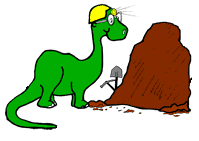Rock Cycle - Understanding the Earth's Crust
by J.R. Blueford, Ph.D.
|
|
K
|
1
|
2
|
3
|
4
|
5
|
6
|
|
Chemistry
(1 week)
|
States
of Matter
|
Characteristics
of Solids
|
Elements
|
Mineral
Composition
|
Compounds
|
New
Compounds from Old
|
Movement
of Molecules
|
|
Minerals
(2
weeks)
|
Describing
Minerals
*(1
week)*
|
Minerals
are Pure
*(1 week)*
|
Mineral
Growth
|
Molecules,
Minerals, & Cleavage
|
Key
Characteristics & Shapes
|
Properties
& Uses of Minerals
|
Predicting
Mineral Properties
|
|
Rocks
(2
weeks)
|
Grouping
Rocks
|
Characteristics
of Rocks
|
Classifying
Rocks
*(1 week)*
|
Identifying
Rocks & Sand
|
Three
Types of Rocks
|
Environments
that create Rocks
|
Analyzing
the Rock Cycle
|
|
Past
Life
(1
week)
|
Discovering
Dinosaurs
*(2 weeks)*
|
Dinosaur
Fossils
*(2 weeks)*
|
Making
& Observing Fossils
*(2 weeks)*
|
Preservation
of Fossils
|
Deriving
Information from Fossils
|
Meaning
of Fossils
|
Importance
of Fossils
|
 The
building blocks of the Rock Cycle are the elements and compounds that are the
ingredients of minerals. Minerals make up three different types of rocks
including igneous, sedimentary, and metamorphic. The Rock Cycle highlights the
methods by which the Earth recycles rock material through the mechanisms of
Plate Tectonics. The primary rock type, igneous is formed in two ways. Extrusive
rocks (volcanic) implies that liquid (molten rock) usually reached the surface
of the Earth through volcanic eruptions. Intrusive rocks (plutonic) refers to
molten rock that does not reach the surface of the Earth, cools beneath the
surface. Agents of erosion such as wind, rain, ice, and gravity will break down
rock that will be cemented later. These rocks are called sedimentary. Increase
of pressure and temperature mainly within the lithosphere cause metamorphic
rocks to form. Past life refers to the fossils that are preserved for us to
interpret past environments.
The
building blocks of the Rock Cycle are the elements and compounds that are the
ingredients of minerals. Minerals make up three different types of rocks
including igneous, sedimentary, and metamorphic. The Rock Cycle highlights the
methods by which the Earth recycles rock material through the mechanisms of
Plate Tectonics. The primary rock type, igneous is formed in two ways. Extrusive
rocks (volcanic) implies that liquid (molten rock) usually reached the surface
of the Earth through volcanic eruptions. Intrusive rocks (plutonic) refers to
molten rock that does not reach the surface of the Earth, cools beneath the
surface. Agents of erosion such as wind, rain, ice, and gravity will break down
rock that will be cemented later. These rocks are called sedimentary. Increase
of pressure and temperature mainly within the lithosphere cause metamorphic
rocks to form. Past life refers to the fossils that are preserved for us to
interpret past environments.
In the Rock Cycle, chemistry comes alive as students are
taught the elements by using the periodic table and how elements combine to form
minerals. Throughout this cycle, emphasis is placed on the connection between
Plate Tectonic Cycle and the Rock Cycle. Learning about fossils revolve around
the present is the key to the past and why evolution is important in helping
geologists time events on Earth.
Chemistry - Students learn
to appreciate the periodic table of elements. They learn about the different
characteristics of elements.
Minerals - Minerals are an
expression of elements and compounds that students can touch and hold. They
learn that minerals have characteristics that identify them.
Rocks - Students learn that
rocks are not just names, but clues of an Earthly history. They learn to
distinguish where rocks were formed.
Past Life - Fossils are a
child's delight. It allows them to use their imagination in understanding the
lives that preceded humans.
Water
Cycle - The Earth's Gift
 The
building blocks of the Rock Cycle are the elements and compounds that are the
ingredients of minerals. Minerals make up three different types of rocks
including igneous, sedimentary, and metamorphic. The Rock Cycle highlights the
methods by which the Earth recycles rock material through the mechanisms of
Plate Tectonics. The primary rock type, igneous is formed in two ways. Extrusive
rocks (volcanic) implies that liquid (molten rock) usually reached the surface
of the Earth through volcanic eruptions. Intrusive rocks (plutonic) refers to
molten rock that does not reach the surface of the Earth, cools beneath the
surface. Agents of erosion such as wind, rain, ice, and gravity will break down
rock that will be cemented later. These rocks are called sedimentary. Increase
of pressure and temperature mainly within the lithosphere cause metamorphic
rocks to form. Past life refers to the fossils that are preserved for us to
interpret past environments.
The
building blocks of the Rock Cycle are the elements and compounds that are the
ingredients of minerals. Minerals make up three different types of rocks
including igneous, sedimentary, and metamorphic. The Rock Cycle highlights the
methods by which the Earth recycles rock material through the mechanisms of
Plate Tectonics. The primary rock type, igneous is formed in two ways. Extrusive
rocks (volcanic) implies that liquid (molten rock) usually reached the surface
of the Earth through volcanic eruptions. Intrusive rocks (plutonic) refers to
molten rock that does not reach the surface of the Earth, cools beneath the
surface. Agents of erosion such as wind, rain, ice, and gravity will break down
rock that will be cemented later. These rocks are called sedimentary. Increase
of pressure and temperature mainly within the lithosphere cause metamorphic
rocks to form. Past life refers to the fossils that are preserved for us to
interpret past environments.